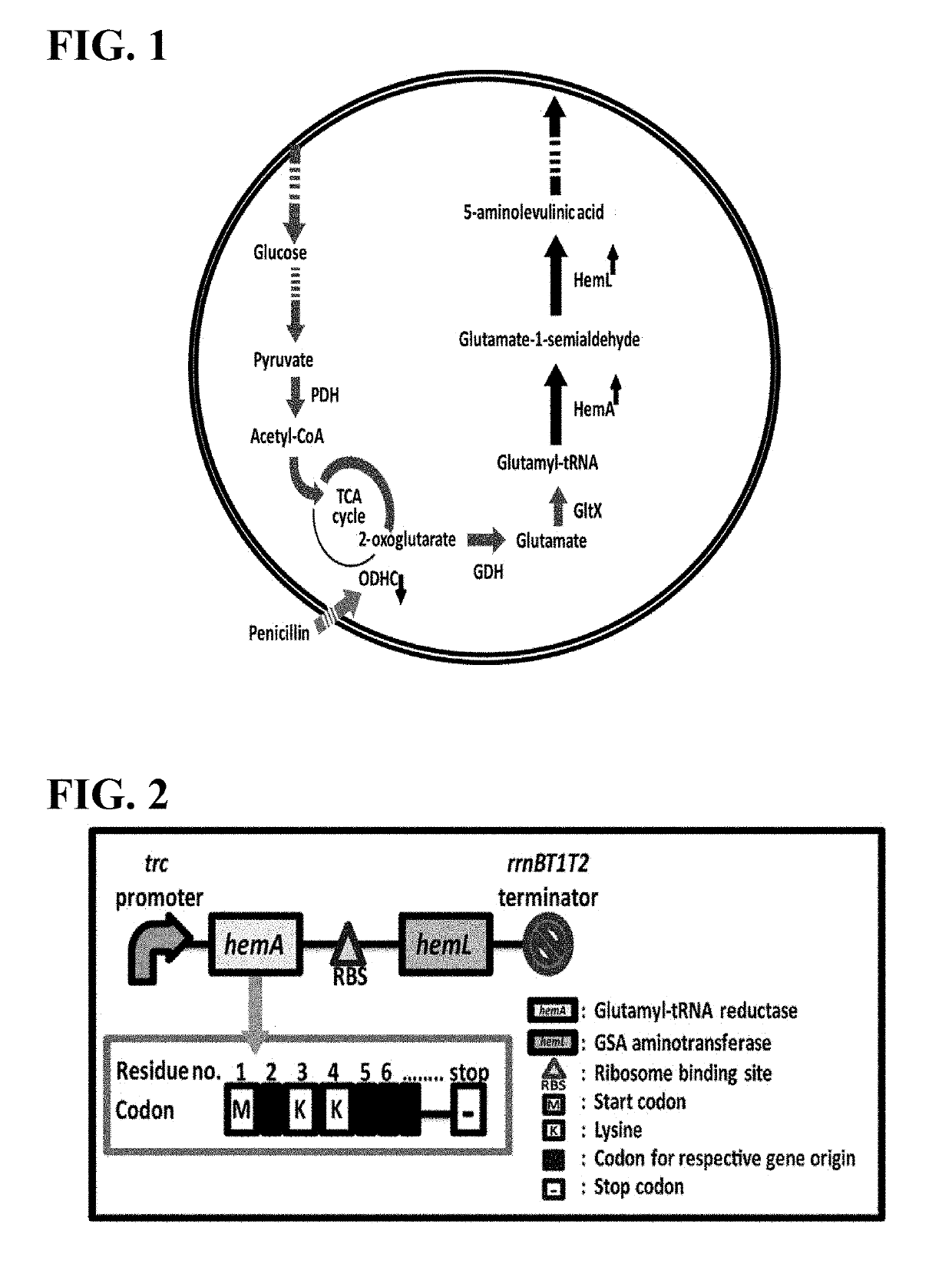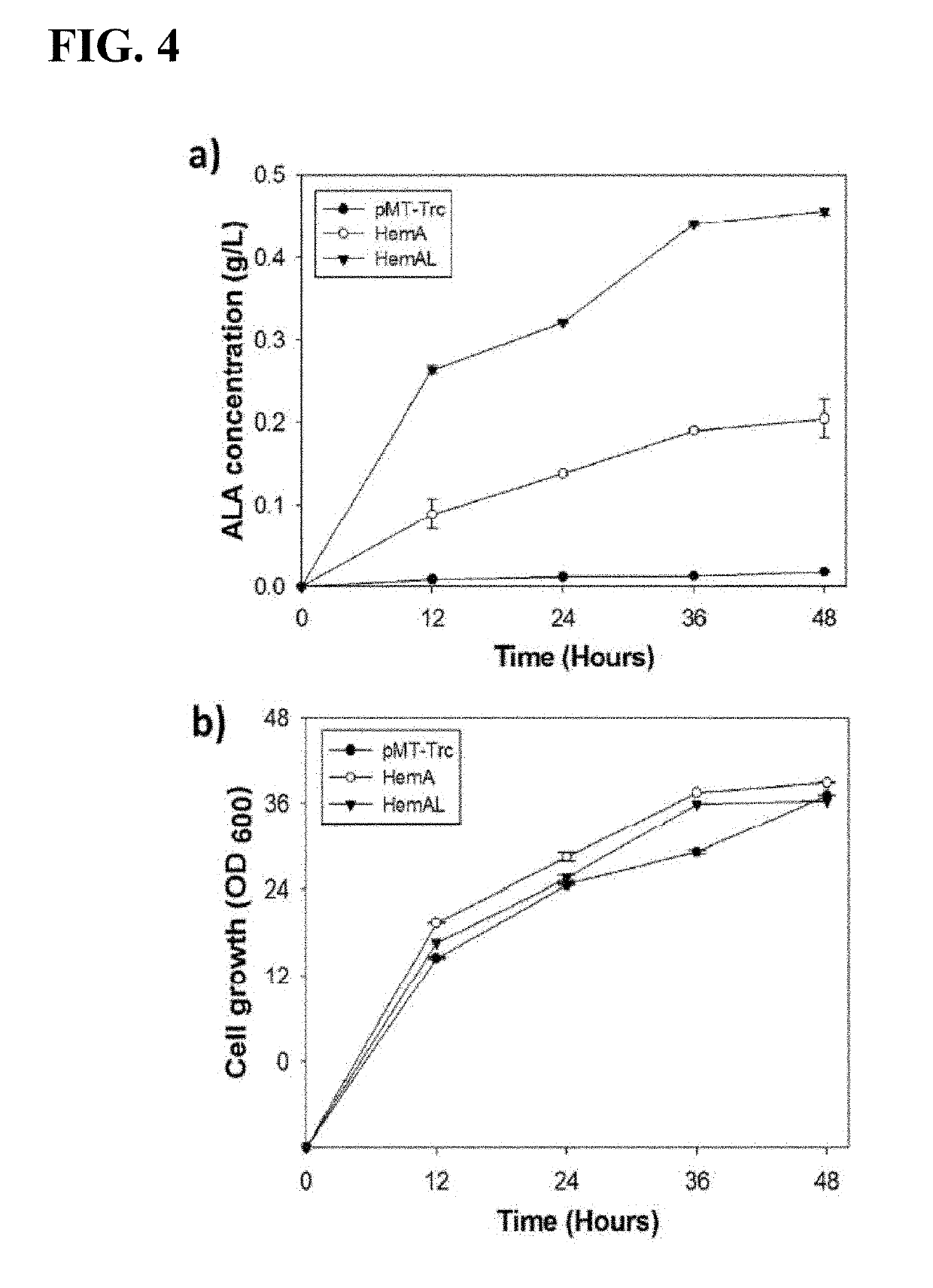Variant microorganism producing 5-aminolevulinic acid and method for preparing 5-aminolevulinic acid using therof
a technology of levulinic acid and variants, which is applied in the direction of enzymology, biochemistry apparatus and processes, transferases, etc., can solve the problems of tumor damage and death, difficult for noxious insects to develop resistance, and complicated stage of action of ala, etc., to achieve the effect of higher yield
- Summary
- Abstract
- Description
- Claims
- Application Information
AI Technical Summary
Benefits of technology
Problems solved by technology
Method used
Image
Examples
example 1
ion of Recombinant Vector by Promoter Replacement for Gene Overexpression
[0054]To construct a recombinant vector, the promoter and signal sequence region of pMTls (Hyun, J E et al., Enzyme Microb. Technol., 371-377, 2011) was replaced with trc promoter that is a constitutive promoter. The trc promoter used for replacement was amplified so that a restriction enzyme XhoI recognition sequence would be inserted into the forward promoter and a restriction enzyme BamHI recognition sequence would be inserted into the reverse promoter. Then, the promoter and signal sequence region of pMTls was replaced with the amplified promoter.
[0055]The constructed recombinant vector was named “pMT-Trc”, and used for expression of each enzyme in the following Examples.
[0056]
pMT-Trc F: (SEQ ID NO: 11)AATAGCCTCGAGCGACTGCACGGTGCACCAATGpMT-Trc R:(SEQ ID NO: 12)GCATTAGGATCCTTCCTGTGTGAAATTGTTATCCG
example 2
on of HemA Gene from Five Kinds of Strains and Introduction of the Gene into Recombinant Vector
[0057]2-1: Acquisition of HemA Gene from Corynebacterium glutamicum
[0058]A glutamyl-tRNA reductase-encoding HemA gene derived from a Corynebacterium glutamicum strain was cloned in the following manner. With reference to the nucleotide sequence of the gene, two lysines were inserted into the 5′ end of the forward primer by introducing the restriction enzyme BamHI and a nucleotide sequence of AAGAAG corresponding to position 7 of the gene sequence, and the sequence of NotI was inserted into the 5′ end of the reverse primer, thereby synthesizing primers. Using the synthesized primers, the gene was amplified by PCR. The amplified gene was introduced into the recombinant pMT-Trc vector.
[0059]
HemA-CG F:(SEQ ID NO: 13)AATAGCGGATCCCATGGATGATTCAGTACGTHemA-CG R:(SEQ ID NO: 14)GATATAGCGGCCGCATTACTCCCTCGTTTGTGTGGC
[0060]2-2: Acquisition of HemA Gene from E. coli
[0061]A glutamyl-tRNA reductase-encodi...
example 3
n of Activities of Five Strain-Derived HemA Genes Having Two Lysines Introduced Therein
[0073]Lysine was introduced into positions 3 and 4 of the amino acid sequence of each strain gene by a PCR technique (FIG. 2).
[0074]
HemA-CG F: (SEQ ID NO: 23)AATAGCGGATCCCATGGATAAGAAGGATTCAGTACGTHemA-CG R:(SEQ ID NO: 24)GATATAGCGGCCGCATTACTCCCTCGTTTGTGTGGCHemA-EC F:(SEQ ID NO: 25)AATAGCGGATCCCATGACCAAGAAGCTTTTAGCACTC HemA-EC R:(SEQ ID NO: 26)AGATTAGCGGCCGCACTACTCCAGCCCGAGGCT HemA-BS F:(SEQ ID NO: 27)GAATCAGGATCCCATGCATAAGAAGATACTTGTTGTG HemA-BS R:(SEQ ID NO: 28)GAATCAGGATCCCATGCATAAGAAGATACTTGTTGTG HemA-ST F:(SEQ ID NO: 29)GCAAGGATCCCATGACCAAGAAGCTTTTAGCGCTCGGT HemA-ST R:(SEQ ID NO: 30)GCAATAGGTACCCTACTCCAGCCCGAGGCT HemA-KP F:(SEQ ID NO: 31)AATAGCGGATCCCATGACCAAGAAGCTTTTAGCTCTT HemA-KP R:(SEQ ID NO: 32)ACTATAGCGGCCGCACTATTCCAGCCCGAGGCT
[0075]Method for Transformation into Corynebacterium glutamicum
[0076]1. Culture Medium and Conditions:
[0077]MB broth: 10 g tryptone, 5 g NaCl, 4 g yeast extract an...
PUM
| Property | Measurement | Unit |
|---|---|---|
| temperature | aaaaa | aaaaa |
| concentration | aaaaa | aaaaa |
| concentrations | aaaaa | aaaaa |
Abstract
Description
Claims
Application Information
 Login to View More
Login to View More - R&D
- Intellectual Property
- Life Sciences
- Materials
- Tech Scout
- Unparalleled Data Quality
- Higher Quality Content
- 60% Fewer Hallucinations
Browse by: Latest US Patents, China's latest patents, Technical Efficacy Thesaurus, Application Domain, Technology Topic, Popular Technical Reports.
© 2025 PatSnap. All rights reserved.Legal|Privacy policy|Modern Slavery Act Transparency Statement|Sitemap|About US| Contact US: help@patsnap.com



